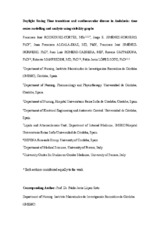Mostrar el registro sencillo del ítem
Daylight Saving Time transitions and Cardiovascular Disease in Andalusia: Time Series Modeling and Analysis Using Visibility Graphs
| dc.contributor.author | Rodríguez-Cortés, Francisco José | |
| dc.contributor.author | Jiménez Hornero, Jorge | |
| dc.contributor.author | Alcalá Díaz, Juan Francisco | |
| dc.contributor.author | Jiménez-Hornero, Francisco José | |
| dc.contributor.author | Romero-Cabrera, Juan Luis | |
| dc.contributor.author | Cappadona, Rosaria | |
| dc.contributor.author | Manfredini, Roberto | |
| dc.contributor.author | López Soto, Pablo Jesús | |
| dc.date.accessioned | 2024-03-04T13:14:04Z | |
| dc.date.available | 2024-03-04T13:14:04Z | |
| dc.date.issued | 2022 | |
| dc.identifier.uri | http://hdl.handle.net/10396/27624 | |
| dc.description.abstract | The present study aimed to determine whether transitions both to and from daylight saving time (DST) led to an increase in the incidence of hospital admissions for major acute cardiovascular events (MACE). To support the analysis, natural visibility graphs (NVGs) were used with data from Andalusian public hospitals between 2009 and 2019. We calculated the incidence rates of hospital admissions for MACE, and specifically acute myocardial infarction and ischemic stroke during the 2 weeks leading up to, and 2 weeks after, the DST transition. NVG were applied to identify dynamic patterns. The study included 157 221 patients diagnosed with MACE, 71 992 with AMI (42 975 ST-elevation myocardial infarction (STEMI) and 26 752 non-ST-elevation myocardial infarction (NSTEMI)), and 51 420 with ischemic stroke. Observed/expected ratios shown an increased risk of AMI (1.06; 95% CI (1.00–1.11); P = .044), NSTEMI (1.12; 95% CI (1.02–1.22); P = .013), and acute coronary syndrome (1.05; 95% CI (1.00–1.10); P = .04) around the autumn DST. The NVG showed slight variations in the daily pattern of pre-DST and post-DST hospitalization admissions for all pathologies, but indicated that the increase in the incidence of hospital admissions after the DST is not sufficient to change the normal pattern significantly. | es_ES |
| dc.format.mimetype | application/pdf | es_ES |
| dc.language.iso | eng | es_ES |
| dc.publisher | Sage | es_ES |
| dc.rights | https://creativecommons.org/licenses/by-nc-nd/4.0/ | es_ES |
| dc.source | Rodríguez-Cortés, F. J., Jiménez-Hornero, J. E., Alcalá‐Díaz, J. F., Jiménez‐Hornero, F. J., Romero-Cabrera, J. L., Cappadona, R., Manfredini, R., & López‐Soto, P. J. (2022). Daylight Saving Time transitions and Cardiovascular Disease in Andalusia: Time Series Modeling and Analysis Using Visibility Graphs. Angiology, 74(9), 868-875. https://doi.org/10.1177/00033197221124779 | es_ES |
| dc.subject | Major acute cardiovascular events | es_ES |
| dc.subject | Acute coronary syndromes | es_ES |
| dc.subject | Cerebrovascular disease | es_ES |
| dc.subject | Daylight Saving Time | es_ES |
| dc.subject | Time series analysis | es_ES |
| dc.title | Daylight Saving Time transitions and Cardiovascular Disease in Andalusia: Time Series Modeling and Analysis Using Visibility Graphs | es_ES |
| dc.type | info:eu-repo/semantics/article | es_ES |
| dc.relation.publisherversion | https://doi.org/10.1177/00033197221124779 | es_ES |
| dc.relation.projectID | Gobierno de España. PI19/01405 | es_ES |
| dc.relation.projectID | Junta de Andalucía. CTS-666 | es_ES |
| dc.rights.accessRights | info:eu-repo/semantics/openAccess | es_ES |

